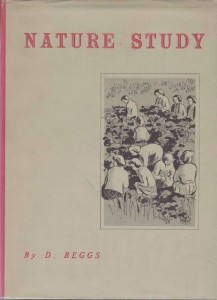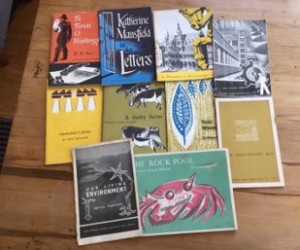The School Publications Branch of New Zealand’s Department of Education was established in 1939, during the second term of the first Labour Government. From 1940 Clarence Beeby, then Director of Education, oversaw the Branch’s activities. According to Beeby, School Publications flourished after he enabled its staff to exercise editorial and creative freedom (Beeby, 1957, p. 5). At one time School Publications was the largest publishing house in the country. For 50 years, it was led by an evolving mix of enthusiastic and avant-garde educators, writers and artists.
Women were active contributors to School Publications from the outset. Two of its chief editors in the 1940s and 1950s were women: Thelma Maurais and Pat Hattaway. Maurais had been a teacher at the experimental high school in Rangiora, and a lecturer for the Workers’ Educational Association. Other women whose careers were supplemented by working for School Publications included Rita Angus, Amelia Batistich, Joy Cowley, Janet Frame, Louise Henderson, Robyn Kahukiwa, Elsie Locke, Margaret Mahy, Ngaio Marsh and Juliet Peter.
The School Journal
The main output for School Publications was initially the School Journal, first produced in 1907 to provide New Zealand school children with locally produced curriculum material. For many years every pupil enrolled in school received a free copy of the Journal.
With the establishment of School Publications and the 1940 centenary of Te Tiriti o Waitangi/The Treaty of Waitangi, the School Journal was refreshed to reflect New Zealand concerns and content. The 1948 series Looking at New Zealand reflected this aim. An editorial in Education called the School Journal’s focus on one theme “experimental and tentative” and requested feedback from teachers on children’s reactions (Anon, 1948, p. 13).
Gregory O’Brien described an “imaginative wave” that swept New Zealand mid-century, generating “remarkable contributions” to the Journal and establishing the careers of many of Aotearoa’s artists and writers (O’Brien, 2007, pp. 8-9).
School Publications and the New Education
The establishment of School Publications was motivated by a range of aspirations, including furthering the New Education movement. According to Beeby: “The School Publications Branch did not just happen to come into existence at this time; it was born of the purpose, created by the movement it had to serve” (1957, p. 6). In keeping with its purpose to ‘serve’ New Educational ideals, 1940s school texts produced by the Branch were often experimental. They encouraged pupils to be active readers and included techniques which prompted questioning of the material within the texts as well as suggested activities to take them beyond (Kelly, 2024). One 1950 School Journal invited readers to write their own story inspired by the cover illustration and send it to the editor.
Its commitment to actively engaging young readers contributed to the Branch being regarded as a leading example of a publishing house for educational texts. Unesco recognised School Publications’ work in 1957 with a report on its activities (Wells, 1957), and in 1960, with a seminar attended by delegates from thirty countries, as former editor and contributor Alistair Campbell recalled (McDonald and Benton, 1992, p. 5).
Primary and Post-Primary School Bulletins
School Publications significantly expanded its output mid-century with its primary and post-primary school bulletins. These bulletins were introduced from 1947 (initially for post-primary readers) to provide background reading for the new and revised subjects, after extensive curriculum revisions generated by the Thomas Report.
The bulletins focused on local subject matter. The Writing in New Zealand series covered local authors, including a bulletin on Katherine Mansfield. Bulletins were also written by New Zealand writers and playwrights, such as Play production by crime writer and director Ngaio Marsh and set designer Samuel Marsh Williams (1948).
Other bulletins were written by New Zealand scientists, lecturers at the universities and training colleges, museum staff, teachers, librarians and public servants.
School Bulletins for Social Studies and Nature Study
Under Maurais’ editorial guidance, many social studies bulletins were produced in collaboration with other government departments. A series of bulletins on town planning and architecture were written jointly by School Publications and the Town Planning Division of the Ministry of Works. Like other social studies bulletins (including Holding a meeting in 1956), these encouraged active citizenship.
Other social studies bulletins provided readers with insight into aspects of working life in New Zealand. The factory worker (1947) by L.S. Hearnshaw and Manufacturing in New Zealand (1955) by G.D. Jenson were concerned with the country’s “secondary industries”. These depicted areas of employment “many pupils from post-primary schools” would eventually work in, according to Hearnshaw (1955, p. 350). The factory worker outlined legislative changes (many by the then Labour Government) that protected workers’ rights; the benefits and provisions of the 1946 Factories Act were outlined in full (p. 358).
The curriculum areas of science and nature study were well-supported by the bulletins. The Our living environment series of post-primary bulletins were written by local scientists and museum curators. Animal habitats was the work of A.W.B. Powell (1947), Fellow of the Royal Society of New Zealand and Assistant Director of the Auckland Museum. Bulletins like The rock pool, by Arthur Torrie (1957), encouraged primary school students to study a distinct local ecology. According to Wells, the photographs and first-person style of The rock pool made it “come alive” for children (1957, p. 20).
Other titles like The forest (1953), The fruit farm (1953), The high country run (1955) and A dairy farm (1960) developed students’ knowledge of agriculture integral to the New Zealand economy.
School Publications for Teachers

David Beggs’ handbook for teaching nature study published in1953
Children were not the only audience School Publications sought to reach. The Branch also published the journals Education: A magazine for teachers (from 1948) and the Education Gazette. Both aimed to support teachers with articles relating to curriculum and pedagogy, as well as social issues and Departmental news.
In 1958 Education ran a special Unesco Issue on rural education, with global contributors as well as New Zealand writers and educators James K. Baxter and Hugh Crawford Somerset. The latter was an active member and one-time branch secretary of the New Education Fellowship, and an adult educator who ran the Feilding Community Centre with his wife Gwendolen (Alley) Somerset. Crawford Somerset was the author of a sociological study of a rural town, Littledene, published by the New Zealand Council for Educational Research (NZCER) in 1938.
School Publications also introduced specialist handbooks for teachers: the Nature study handbook by David Beggs (1953) of Christchurch’s Training College was the first of these.
School Publications: Key debates
Occasionally, School Publications published material that created a stir. This happened with the publication in the School Journal of ‘Our street’, a story by Brian Sutton-Smith (with illustrations by Juliet Peter) in 1949. ‘Our street’ upset some readers with its use of slang and portrayal of mildly dissolute urban youth, seen as promoting anti-social behaviour (Kelly, 2024). This story was deleted from the Journal before publication.
One 1958 primary school bulletin significant to historical debate is Te Tiriti O Waitangi, written by historian Ruth Ross. Its significance derives from the fact it was a government produced publication which supported Māori claims about the mistranslation of sections of Te Tiriti o Waitangi, which differed significantly from the English-language version. This was at a time when the government, and many historians, did not acknowledge a discrepancy.
Ross’s bulletin drew on Māori accounts of the signing at the Wesleyan mission of Mangungu in the Hokianga, where Ross lived at the time. Informed by conversations with local rangitira who drew on memories of events as passed down, it was revisionist history published in the unexpected quarter of a 1950s primary school text. Bain Attwood considered that School Publications suited Ross “because it encouraged its authors to take an independent line and challenge conventional opinion” and because of its commitment to publishing material related to Māori (2023, p. 35).
A significant debate in Aotearoa’s educational history also centred on a School Publications text, Washday at the pā by Ans Westra (1964). This bulletin was withdrawn from schools and destroyed after protest by the Māori Women’s Welfare League over the booklet’s representation of a Māori family and home. Historian Barbara Brookes outlined elements of the protest and debate, and quoted Jo Heta, the Tai Rawhiti District Council Delegate, who stated that “The Department of Education should assure the Dominion Council that the booklet be withdrawn and such an incident never happen again” (2000, p. 218). Georgina Tuari Stewart suggests the debate is reflective of a wider “battle for Māori control over the representation of Māori in the public sphere” and is particularly significant for Māori women’s struggle for agency over “their lives and images of their lives” (2019, p. 687).
As the examples of ‘Our street’, Washday at the Pā and Te Tiriti O Waitangi highlight, there were difficulties for government produced school publications that might be seen to represent state-sanctioned views.

Part of author’s collection of School Publication Branch bulletins. Source: F. Kelly
School Publications and language
Although most School Publications texts were in English, from mid-century the Branch also produced bulletins and other texts in te reo Māori (Māori language) including the Te Wharekura series. Teacher and lecturer in Māori studies, Timoti Kāretu (Ngāi Tūhoe, Ngāti Kahungunu, Ngāti Raukawa) wrote the Te Wharekura school bulletin Aku haerenga i te ao (1964) during his time as Information Officer at the New Zealand High Commission in London; Kāretu went on to become Aotearoa New Zealand’s Māori Language Commissioner in 1992.
The School Publications editor overseeing Māori texts in the 1970s was educator and composer Hirini Melbourne (Ngāi Tūhoe, Ngāti Kahungunu) who led the Haumanu movement, the revival of taonga puoro (traditional Māori instruments). Llewelyn Richards, a colleague at School Publications, remembered te reo texts flourishing under Melbourne’s editorial guidance and that his well-known bird songs were first written at the Branch, for children (McDonald and Benton, 1992).
Schools in the Pacific Islands received School Publications’ journals and readers in Pacific languages from the late 1940s. According to Wells’ report for Unesco, the Department released books in Rarotongan (for use in Cook Island schools), Niuean, Samoan and Tokelauan languages. The first Samoan language school journal was published in 1947. Scholars, linguists and teachers were supportive of the aim to produce accessible texts for Pacific school readers in their first language, although later pressure was exerted to include English language translations and summaries (Wells, 1957).
Impact and fate of School Publications
As a branch of government Department of Education’s School Publications upheld and extended government reach into schools in Aotearoa New Zealand and its territories. However, it was also a publishing house that produced children’s texts which were experimental, innovative, creative and even radical. With the 1989 Education Act the Department of Education was disestablished and its School Publications Branch rebranded as Learning Media, which was in turn disestablished in 2013, although the School Journal continues.
School Publications Branch texts referred to in this entry
Beggs, D. 1953. Nature study handbook. Wellington: School Publications Branch, Department of Education.
Hearnshaw, L.S. 1947. The factory worker. Wellington: School Publications Branch, Department of Education.
Jenson, G.D. 1955. Manufacturing in New Zealand. Wellington: School Publications Branch, Department of Education.
Kāretu, T. 1964. Aku haerenga i te ao. Wellington: School Publications Branch, Department of Education.
Marsh, N. and Williams, S.M. 1960. Play production. Wellington: School Publications Branch, Department of Education.
Powell, A.W.B. 1947. Animal habitats. Wellington: School Publications Branch, Department of Education.
Torrie, A. 1957. The rock pool. Wellington: School Publications Branch, Department of Education.
Ross, Ruth. 1958. Te Tiriti o Waitangi. Wellington: School Publications Branch, Department of Education.
Sutton-Smith, Brian. 1949. ‘Our street’. School Journal 43(6-8). Wellington: School Publications Branch, Department of Education.
Westra, Ans. 1964. Washday at the pā. Wellington: School Publications Branch, Department of Education.

